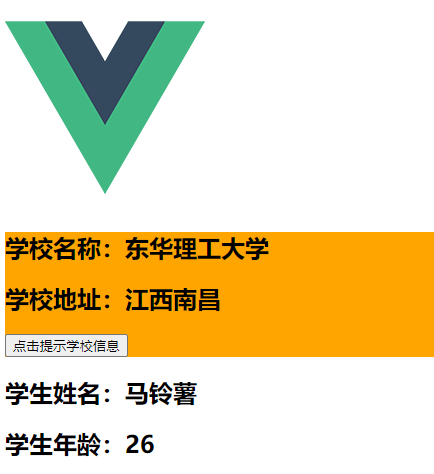将 24-Vue组件化编程-单文件组件 放到使用Vue脚手架创建的vue_test项目中
脚手架文件结构
├── node_modules
├── public
│ ├── favicon.ico: 页签图标
│ └── index.html: 主页面
├── src
│ ├── assets: 存放静态资源
│ │ └── logo.png
│ │── component: 存放组件
│ │ └── HelloWorld.vue
│ │── App.vue: 汇总所有组件
│ │── main.js: 入口文件
├── .gitignore: git版本管制忽略的配置
├── babel.config.js: babel的配置文件
├── package.json: 应用包配置文件
├── README.md: 应用描述文件
├── package-lock.json:包版本控制文件
src/components/School.vue
<template> <!--组件的结构--> <div class="demo" style="background-color:orange;"> <h2>学校名称:{{schoolName}}</h2> <h2>学校地址:{{address}}</h2> <button @click="showName">点击提示学校信息</button> </div> </template> <script> // 组件交互相关的代码(数据、方法) export default { // eslint-disable-next-line vue/multi-word-component-names name:"School", data(){ return{ schoolName:"东华理工大学", address:"江西南昌" } }, methods:{ showName(){ alert(this.schoolName) } } } </script> <style> //组件的样式 .demo { //background-color: orange; } </style>
src/components/Student.vue
<template> <!--组件的结构--> <div> <h2>学生姓名:{{name}}</h2> <h2>学生年龄:{{age}}</h2> </div> </template> <script> // 组件交互相关的代码(数据、方法) export default { // eslint-disable-next-line vue/multi-word-component-names name:"Student", data(){ return{ name:"马铃薯", age:26 } } } </script> <style> </style>
src/App.vue
<template> <div> <img src="./assets/logo.png"> <!--使用组件标签--> <School></School> <Student></Student> </div> </template> <script> // 引入组件 import School from "./components/School.vue"; import Student from "./components/Student.vue"; export default { name:"App", // 注册组件 components:{ School:School, Student:Student } } </script> <style> </style>
src/main.js
// 该文件是整个项目的入口文件 // 引入Vue(残缺版) import Vue from 'vue' // 引入Vue(完整版) // import Vue from 'vue/dist/vue' // 引入App组件,它是所有组件的父组件 import App from './App.vue' // 阻止 vue 在启动时生成生产提示 Vue.config.productionTip = false // 创建Vue实例对象 vm // new Vue({ // render: h => h(App), // }).$mount('#app') new Vue({ el:"#app", // 下面这行代码一会解释,完成了这个功能:将App组件放入容器中 render: h => h(App), // 引入Vue(残缺版)写法 // render(createElement){ // console.log(666) // return createElement("h1","你好啊") // } // 引入Vue(完整版)写法 // template:"<h1>你好啊</h1>", // components:{App:App} })
public/index.html
<!DOCTYPE html> <html lang=""> <head> <meta charset="utf-8"> <!-- 针对IE浏览器的一个特殊配置,含义是仍IE浏览器以最高的渲染级别渲染页面 --> <!-- Vue不支持IE8及以下的版本,因为Vue使用了IE8无法模拟的ECMAScript 5特性。但它支持所有兼容ECMAScript 5的浏览器 --> <meta http-equiv="X-UA-Compatible" content="IE=edge"> <!-- 开启移动端的理想视口 --> <meta name="viewport" content="width=device-width,initial-scale=1.0"> <!-- 配置页签的图标 --> <link rel="icon" href="<%= BASE_URL %>favicon.ico"> <!-- 配置网页的标题 --> <title><%= htmlWebpackPlugin.options.title %></title> </head> <body> <!--当浏览器不支持js时,noscript中的元素就会被渲染--> <noscript> <strong>We're sorry but <%= htmlWebpackPlugin.options.title %> doesn't work properly without JavaScript enabled. Please enable it to continue.</strong> </noscript> <div id="app"></div> <!-- built files will be auto injected --> </body> </html>
